How to Cut Concrete Pavers Without a Saw: 3 Simple Ways
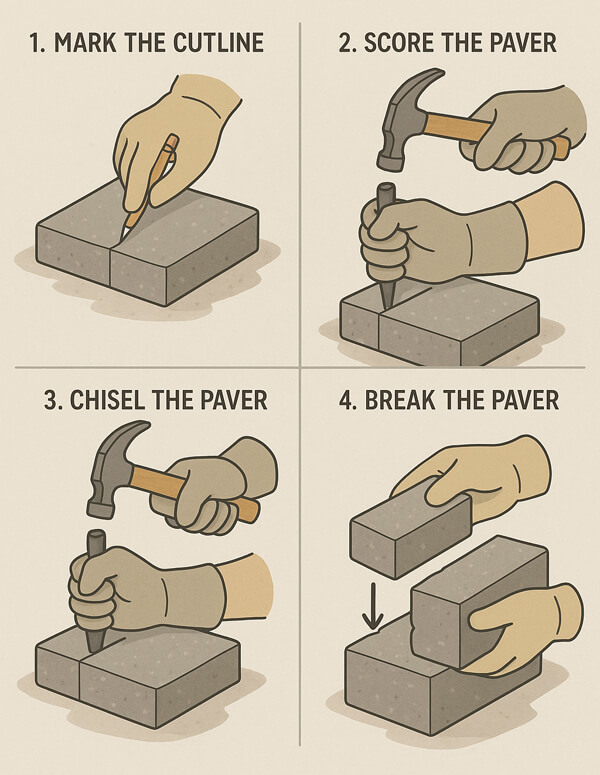
Cutting concrete pavers without a saw is entirely possible. It does not require advanced skills. It is a great way to save money on small projects. Manual cutting methods can be learned quickly.
Sometimes you simply don’t have access to a saw. You might be working in a backyard with no power supply. Or you want to avoid the noise and dust of power tools.
Many homeowners cut pavers for garden edging or patio work. Walkway repairs also require cutting single pavers to size. You might need to fit around posts, curves, or drains.
The good news is that you can cut pavers without expensive equipment. You only need patience. You also need the right method. With both, you can get clean, professional results. The key is knowing which tools and techniques work best for your paver type.
Contents
Understanding Concrete Pavers Before Cutting
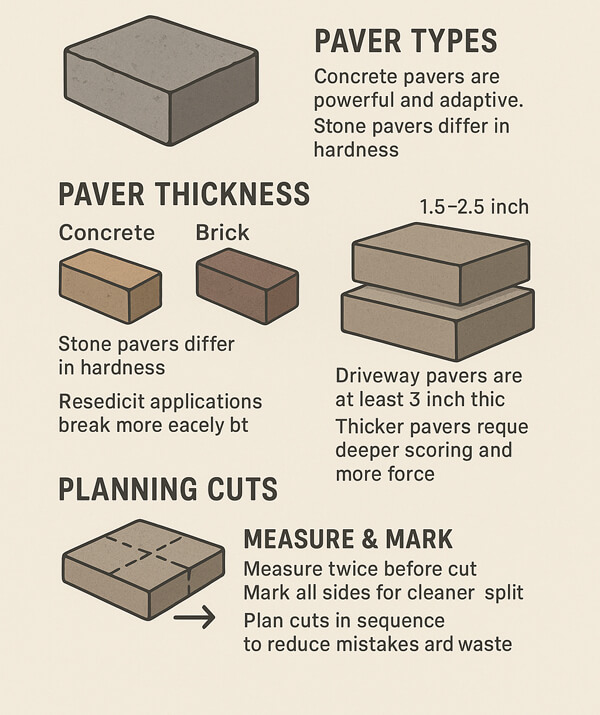
Before understanding the cutting process, it is better to understand pavers first. Here are some details for concrete pavers.
Paver Types
Concrete pavers are powerful and adaptive. They are manufactured out of cement, sand, and stone aggregate. They are consistent in the density thus aids in consistent breaking. Brick pavers are brittle and will scratch off.
Stone pavers also differ, granite is hard whereas paving with limestone is soft. The type of cutting you apply must correspond to the hardness of material.
Paver Thickness
Pavers used mostly in residential applications are between 1.5 to 2.5 inches. Driveway pavers are often 3 inches or thicker. Thin pavers break more easily but can chip if hit too hard. Thicker pavers need deeper scoring and more force.
Planning Cuts
Always measure the cut twice and cut once. Mark all sides of the paver for a cleaner split. Account for joint gaps in your layout. Plan your cuts in sequence to reduce mistakes and waste. Having a cutting plan in place before getting started, will save time and materials.
Safety Precautions (Non-Negotiable)
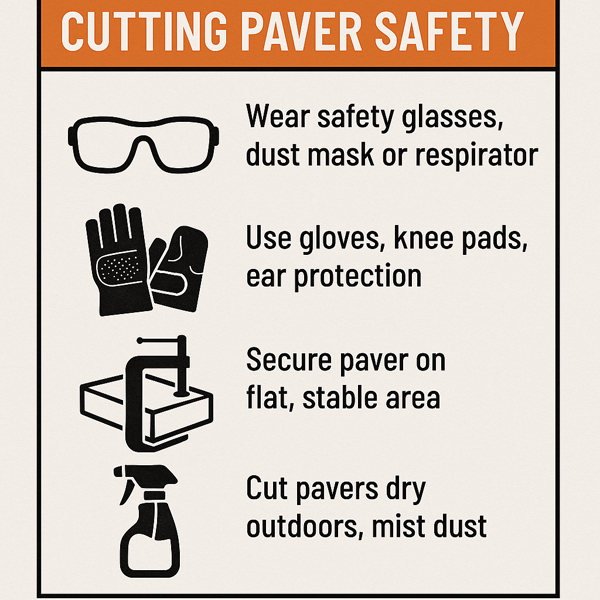
First should always be safety. Following are some safety precautions that are must to observe during cutting pavers. In case of negligence, it can cause health and life hazards.
- When working, use safety glasses to cover eyes because they might be hit by flying chips. Airborne fine particles are obstructed by your lungs using a dust mask or respirator.
- Wear grip and hand protection gloves during work. In case of kneeling put on knee pads which prevent strain. When using powered tools, add ear protection.
- Install your work area on a solid, flat surface. Make certain that the space is well lighted. To avoid movement use clamps or wedges to hold the pavers in place. Keep off a paver in your lap because it is unsafe.
- When cutting dry, do it outside and dust with a little spray of water. You should do nothing to make the paver wet since wet surfaces are slippery. Before you break out, clear a working area of stumbling block.
Tools You Can Use Instead of a Saw
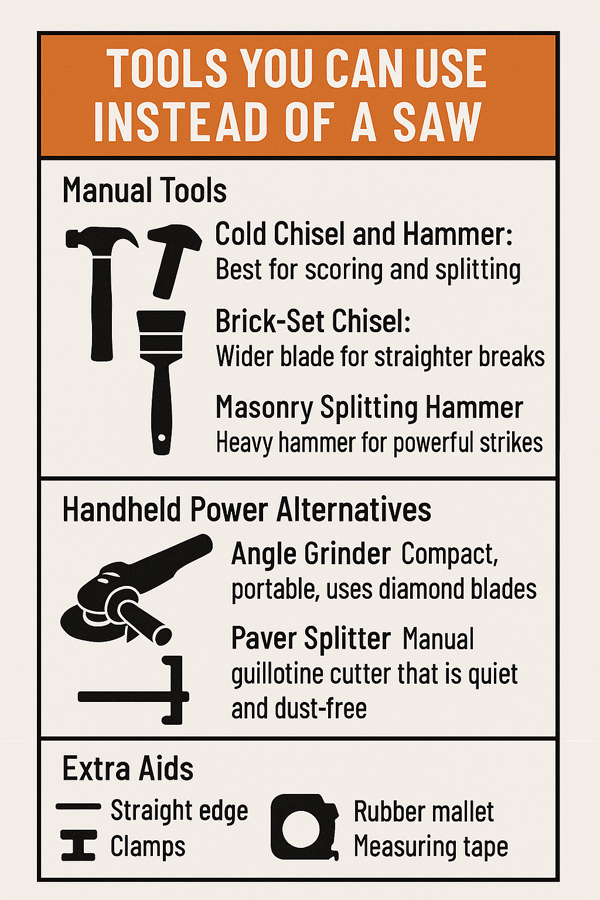
For cutting concrete pavers, we have different kind of tools. As cutting can be done manually and with power. So, the tools are separate for both types of cutting. Here are the details for each type of cutting tools:
Manual Tools
These are the tools that don’t require any power to operate. These can be used by only manpower. Following are some common tools for cutting concrete pavers.
- Cold Chisel and Hammer: Best for scoring and splitting.
- Brick-Set Chisel: Wider blade for straighter breaks.
- Masonry Splitting Hammer: Heavy hammer for powerful strikes.
Handheld Power Alternatives
These tools require electric power or batteries to operate. However, a personnel is required to hold them for accuracy. These are:
- Angle Grinder: Compact, portable, and uses diamond blades.
- Paver Splitter: Manual guillotine cutter that is quiet and dust-free.
Extra Aids
Not only tools, but we need some extra aiding tools. They cannot directly cut the concrete pavers but help through the process. Here are the aiding tools:
- Straight edge is useful for accurate marking.
- Clamps are used for holding pavers still.
- Rubber mallet is required for gentle adjustments.
- Measuring tape can be utilized in terms of more accurate sizing.
The selection of a tool will depend on the size of your project, type of pavers and place they are to be used.
Method 1 – Hammer and Chisel Technique
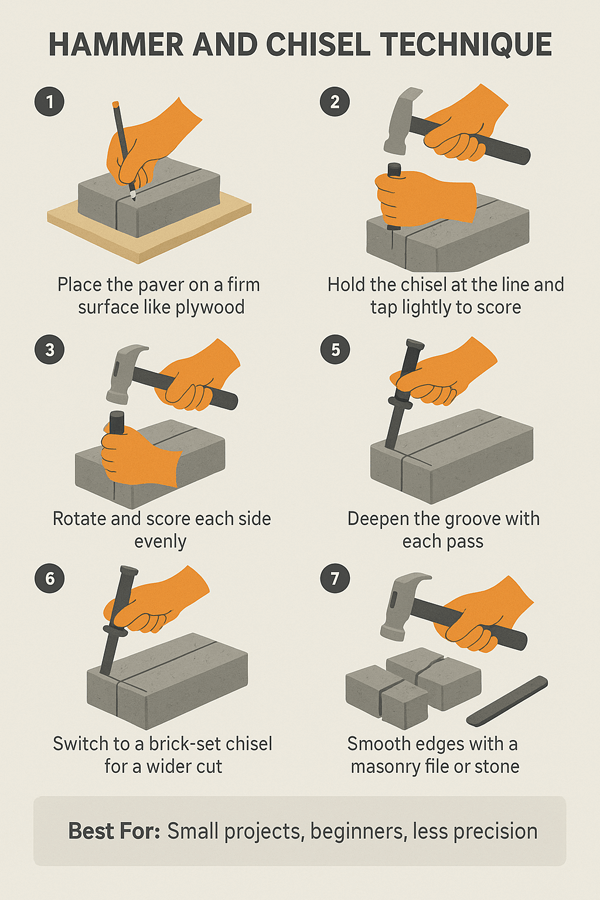
When we talk about cutting method for concrete pavers, there are almost six methods. These are classified according the tools used. Here is the first method. It includes the hammer and chisel technique for cutting concrete pavers.
One of the oldest means of cutting pavers is called the hammer and chisel method. It does not even necessitate power tools but only the basic hand ones. It is cheap, easy, and even practiced all over.
Step-by-Step
- Measure and mark your cut line on all sides.
- Place the paver on a firm surface like plywood.
- Hold the chisel at the line and tap lightly to score.
- Rotate and score each side evenly.
- Deepen the groove with each pass.
- Switch to a brick-set chisel for a wider cut.
- Deliver a firm strike to split the paver.
- Smooth edges with a masonry file or stone.
Best For: It is best for small projects. Due to simple operation, beginners can use it. It is useful method where precision isn’t critical.
Method 2 – Using a Paver Splitter (Block Splitter)
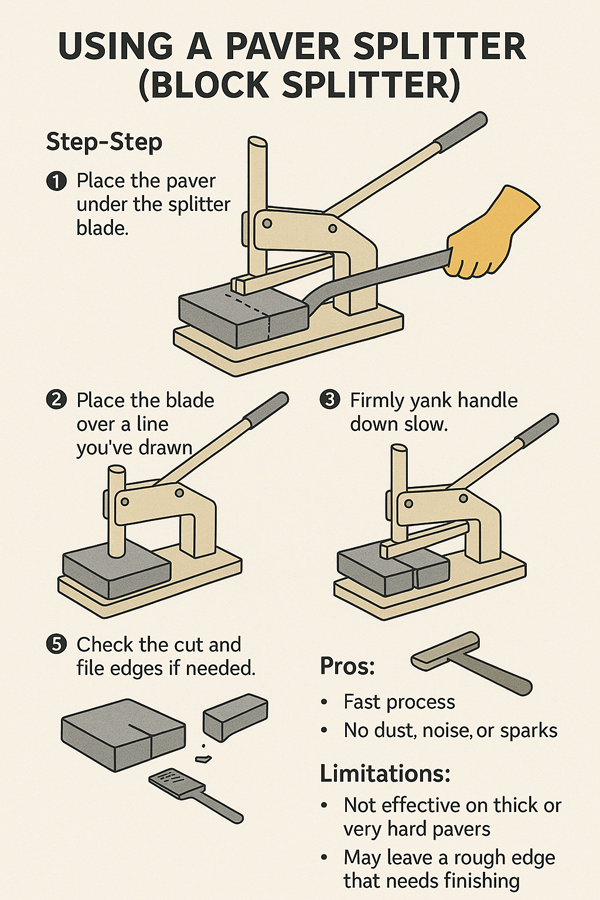
The second one is the application of a paver splitter or a block splitter. This instrument is a manual guillotine. It splits the paver in two pieces by the means of a sharp blade and down pressure.
Paver splitters will work well when making a repeat cut. They are effective in such projects as patios or garden path. They are usable both inside and outside without bothering or annoying neighbors.
Step-by-Step
- Place the paver under the splitter blade.
- Place the blade over a line which you have drawn.
- Roughly yank handle down slow.
- Let the paver snap under pressure.
- Check the cut and file edges if needed.
Pros: It is a fast process. This process doesn’t produce noise. It produce no dust, no noise and no sparks. .
Limitations Not effective on thick or very hard pavers. May leave a rough edge that needs finishing.
Method 3 – Using an Angle Grinder (Optional Power Method)
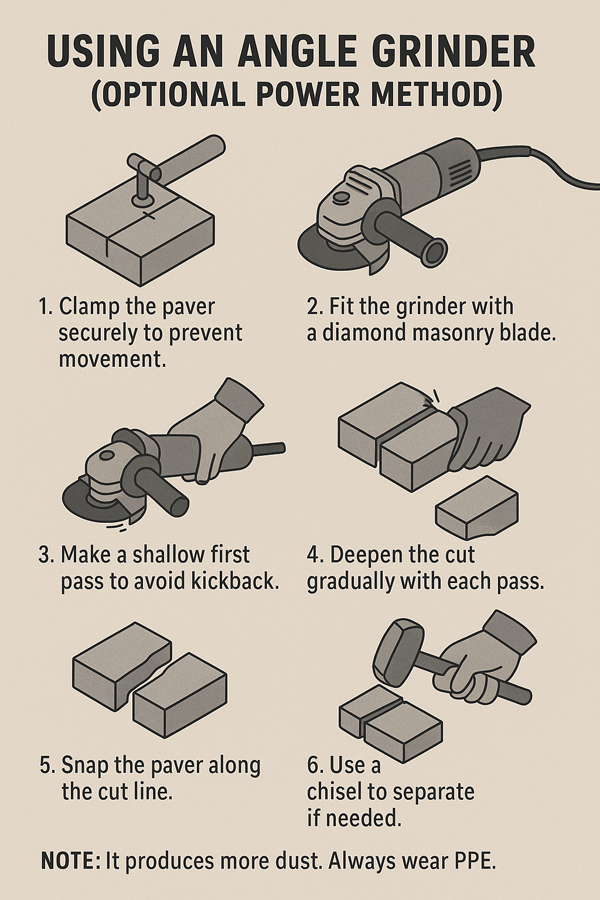
Angle grinder is a power tool that is small and handheld. When a diamond masonry blade is bolted on, it is able to cut pavers neatly. It is smaller compared to a saw, and it is easy to move around in the small spaces.
Although it is technically a power tool it can be used as an alternative. If one does not have an entire masonry saw it can be good option.
Step-by-Step
- Clamp the paver securely to prevent movement.
- Fit the grinder with a diamond masonry blade.
- Make a shallow first pass to avoid kickback.
- Deepen the cut gradually with each pass.
- Snap the paver along the cut line.
- Use a chisel to separate if needed.
Note: It produces more dust. Always wear PPE.
Special Cuts Without a Saw
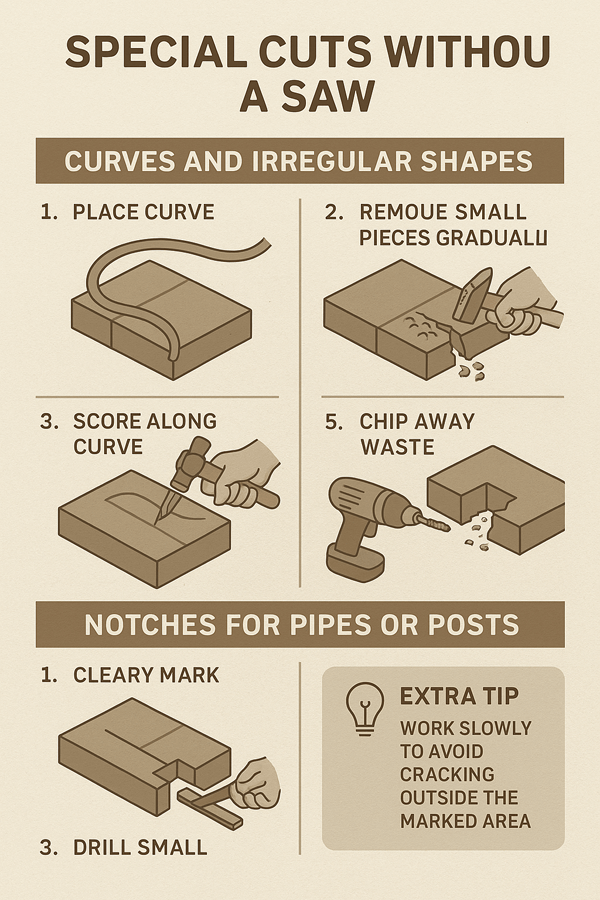
Not every single cut is a straight line. You may have to cut curves or notches or those nasty shapes. This can yet be done without a saw. More time, more even-mindedness, and more careful labor are all that are needed.
- Curves and Irregular Shapes Trace the curve with a flexible hose or rope. Score along the curve with a chisel. Remove small pieces gradually to form the shape.
- Notches for Pipes or Posts Mark the notch clearly. Drill small holes along the line. Chip away the waste material with a chisel. Work slowly to avoid cracking outside the marked area.
Common Mistakes to Avoid
It is very easy to cut pavers without a saw; however, errors can destroy everything. Being aware of what not to do will be time-saving, resources saving and frustration free. You must avoid these mistakes:
- Hitting too hard at the start can cause uneven cracks.
- Marking only the top leads to jagged edges.
- Skipping PPE risks injury and breathing hazards.
- Cutting on an unstable surface cause accident.
- Not scoring evenly makes splits unpredictable.
Tips for a Professional Finish Without a Saw
Here are some useful tips for cutting concrete pavers. They are as below:
- Score deeper before splitting to get cleaner edges.
- Use a masonry file or rubbing stone to smooth surfaces.
- Match the angle of factory edges for a uniform look.
- Always test your method on scrap pieces first.
- Never go to work on scrap immediately.
- Sharp tools will give improved outcomes.
When to Rent or Borrow a Saw Instead
If you are confused between rent and borrow, here is a guide:
- Consider renting a saw for very thick pavers.
- Large patios with many cuts are faster with a saw.
- Dense materials like granite need more cutting power.
- A saw is best for perfect, precise edges in visible areas.
Conclusion
Cutting pavers without a saw is possible. Manual techniques can give clean, accurate results. You do not need expensive tools for small or medium projects.
There is a need to wait patiently. Get correct equipment. The safety precautions should be observed at all costs. Start with small cuts first. Choose low-risk areas to practice. Work on scrap pavers before cutting visible ones.
For more help, check our related guides. See our tips on dust control. Read our patio laying guide. Learn how to install edging for a professional finish.
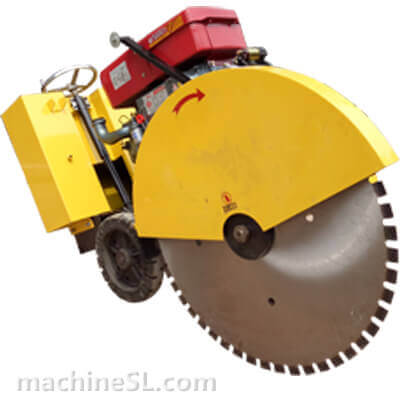
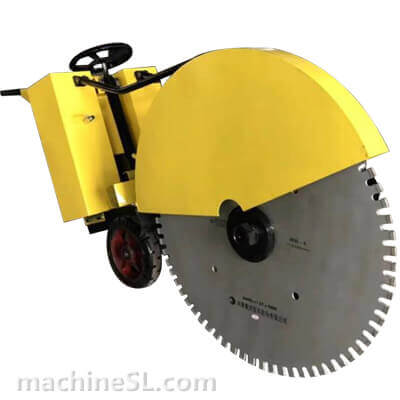
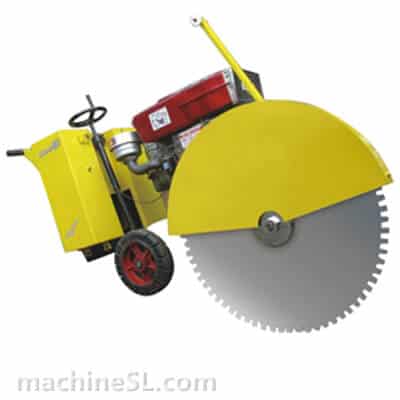








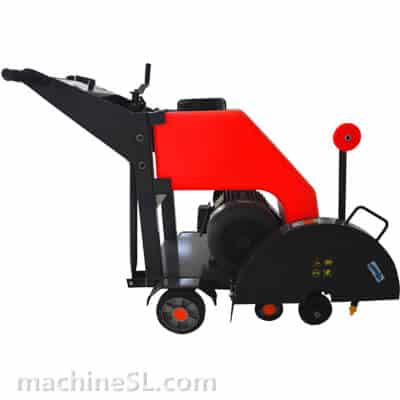

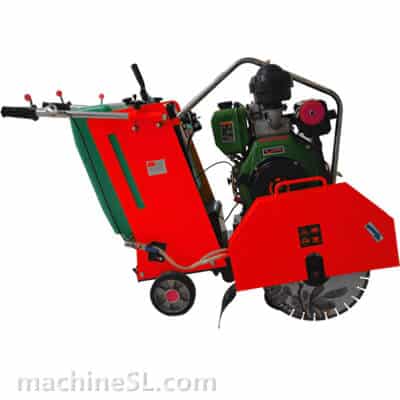

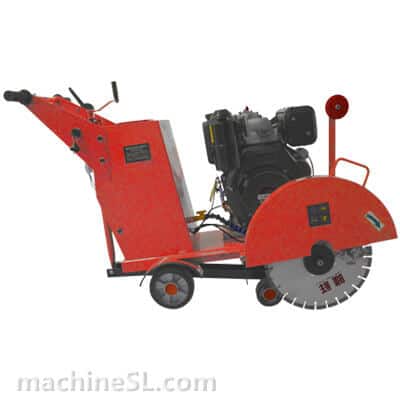


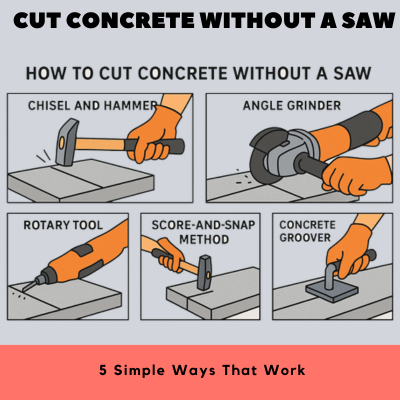
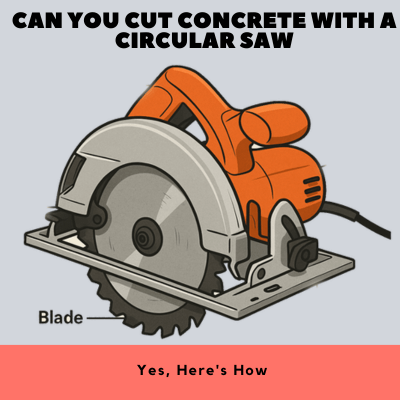
Leave A Comment